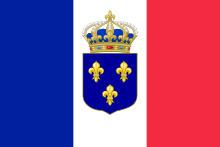- Monarchism in France
-
Monarchism in France is the advocacy of restoring the monarchy (mostly constitutional monarchy) in France, which was abolished after the 1870 defeat against Prussia, arguably before that in 1848 with the establishment of the French Second Republic.
The French monarchist movements are roughly divided today in three groups:
- The Legitimists for the royal House of Bourbon,
- the Orléanists for the cadet branch of the House of Orleans, and
- the Bonapartists for the imperial House of Bonaparte
Contents
History
In France, Louis-Philippe abdicated on February 24, 1848, opening the way to the Second Republic (1848–52), which lasted until Napoleon III's December 2, 1851 coup d'état and the establishment of the Second Empire (1852–1870). The monarchist movement came back into force only after the 1870 defeat against Prussia and the crushing of the 1871 Paris Commune by Orleanist Adolphe Thiers. Legitimists and Orleanists controlled the majority of the Assemblies, and supported Patrice de Mac-Mahon, Duke of Magenta, as president of the Ordre moral government.
 The French tricolore with the royal crown and fleur-de-lys was possibly designed by Henri, comte de Chambord in his younger years as a compromise[1]
The French tricolore with the royal crown and fleur-de-lys was possibly designed by Henri, comte de Chambord in his younger years as a compromise[1]
But the intransigeance of the comte de Chambord, who refused to abandon the white flag and its fleur-de-lys against the republican tricolore, and the May 16, 1877 crisis forced the legitimists to abandon the political arena, while some of the more liberal Orleanists "rallied" throughout the years to the Third Republic (1870–1945). However, since the monarchy and Catholicism were long entangled ("the alliance of the Throne and the Altar"), republican ideas were often tinged with anti-clericalism, which led to some turmoil during Radical Emile Combes' cabinet in the beginning of the 20th century.
The Action Française, founded in 1898 during the Dreyfus affair, remained an influential far right movement throughout the 1930s, taking part in the February 6, 1934 riots. Some monarchists, such as Georges Valois who founded the Faisceau, became involved in fascism after the 1926 Papal condemnation of the Action Française by Pius XI.
Monarchists were then active under the Vichy regime, with the leader of the Action Française Charles Maurras qualifying as "divine surprise" the overthrow of the Republic and the arrival to power of Marshal Pétain. A few of them, such as Henri d'Astier de la Vigerie, took part in the Resistance out of patriotic concerns. The Action Française was then dissolved after the war, but Maurice Pujo founded it again in 1947.
Some legitimists had become involved in the traditionalist Catholic movement which arose in the aftermath of the Second Vatican Council and some ultimately followed the 1970 foundation of the traditionalist Catholic Society of St. Pius X by Marcel Lefebvre. Bertrand Renouvin made a breakaway movement from the Action Française in 1971, the Nouvelle Action Française which became the Nouvelle Action Royaliste, while some legitimists joined Jean-Marie Le Pen's Front National, founded in 1972.
Current pretenders
The most recognised pretenders to the French throne are Prince Henri, Count of Paris, Duke of France for the Orleanists, Louis Alphonse, Duke of Anjou for the Legitimists, and Jean Christophe, Prince Napoléon for the Bonapartists.
Monarchist groups
Falling into one of the to the three main monarchist streams, some of the active groups in France today are:
- Action Française
- Alliance Royale
- Rassemblement démocrate
- Nouvelle Action Royaliste
References
- ^ Whitney Smith. Flags through the ages and cross the world. McGraw-Hill Book Company. 1975. pg. 75
External links
Categories:
Wikimedia Foundation. 2010.
